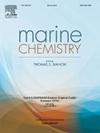利用铝和210Pb追踪大陆边缘底部沉积物中颗粒有机碳的跨陆架运输和积累
IF 2.5
3区 地球科学
Q2 CHEMISTRY, MULTIDISCIPLINARY
引用次数: 0
摘要
以铝(Al)和210Pb为示踪剂,研究了东/日本海陆架到海盆底部的颗粒有机碳(POC)运输。研究结果表明,210Pb在盆地(2327 m)的沉积沉积量与水柱的清除去除通量(117±15%)相当,而在陆架(200 m)的沉积沉积量增加了3倍(296±50%),表明陆架源沉积物有大量的侧向输入。我们还表明,在沉积速率较低的大陆边缘沉积物中,常规使用的不考虑混合的过量210pb沉积速率可能被高估3-8倍(<;0.15 cm yr - 1),导致对POC埋藏通量的严重高估。基于Al质量平衡和沉积210Pb收支的沉积速率与14C和tephra分析的沉积速率更接近。利用精细化沉降速率建立的POC盒模型表明,东海POC埋藏通量为初级产量的0.3 ~ 1.0%。这些值比以前根据同一地区210pb沉积速率估算的值低4倍,但与在类似海洋环境中观测到的值一致。此外,POC箱型模型表明,沉积物再悬浮对底部沉积物POC通量的下降有显著贡献(34 - 70%)。因此,我们的研究结果表明,在大陆边缘,由于沉积速率缓慢,210Pb的衰变和混合难以区分,传统的210Pb测年方法可能会显著高估沉积速率和相关物质通量。本文章由计算机程序翻译,如有差异,请以英文原文为准。
Tracing cross-shelf transport and accumulation of particulate organic carbon in the continental margin bottom sediments using Aluminum and 210Pb
We investigated particulate organic carbon (POC) transport across the shelf to the basin bottom in the East/Japan Sea, using Aluminum (Al) and 210Pb as tracers. Our results show that the sedimentary deposition of 210Pb in the basin (2327 m) is comparable with the scavenging removal flux from the water column (117 ± 15 %), whereas it increases threefold in the shelf (296 ± 50 %) (200 m), suggesting substantial lateral inputs of land- and shelf-origin sediments. We also show that conventionally used excess 210Pb-derived sedimentation rates without considering mixing can be overestimated by 3–8 times in continental margin sediments, where sedimentation rates are low (< 0.15 cm yr−1), leading to significant overestimation of POC burial fluxes. Sedimentation rates based on an Al mass balance with sedimentary 210Pb budgets align more closely with those from 14C and tephra analyses in this region. A POC box model using the refined sedimentation rate indicates that POC burial fluxes in the East Sea are 0.3–1.0 % of primary production. These values are four times lower than previous estimates based on 210Pb-derived sedimentation rates in the same region, but consistent with those observed in similar oceanic settings. Additionally, the POC box model suggests that sediment resuspensions can significantly contribute (34–70 %) to sinking POC fluxes in the bottom sediments. Thus, our results highlight that in continental margins, where 210Pb decay and mixing are difficult to distinguish due to slow sedimentation rates, traditional 210Pb dating methods can significantly overestimate sedimentation rates and associated material fluxes.
求助全文
通过发布文献求助,成功后即可免费获取论文全文。
去求助
来源期刊

Marine Chemistry
化学-海洋学
CiteScore
6.00
自引率
3.30%
发文量
70
审稿时长
4.5 months
期刊介绍:
Marine Chemistry is an international medium for the publication of original studies and occasional reviews in the field of chemistry in the marine environment, with emphasis on the dynamic approach. The journal endeavours to cover all aspects, from chemical processes to theoretical and experimental work, and, by providing a central channel of communication, to speed the flow of information in this relatively new and rapidly expanding discipline.
 求助内容:
求助内容: 应助结果提醒方式:
应助结果提醒方式:


